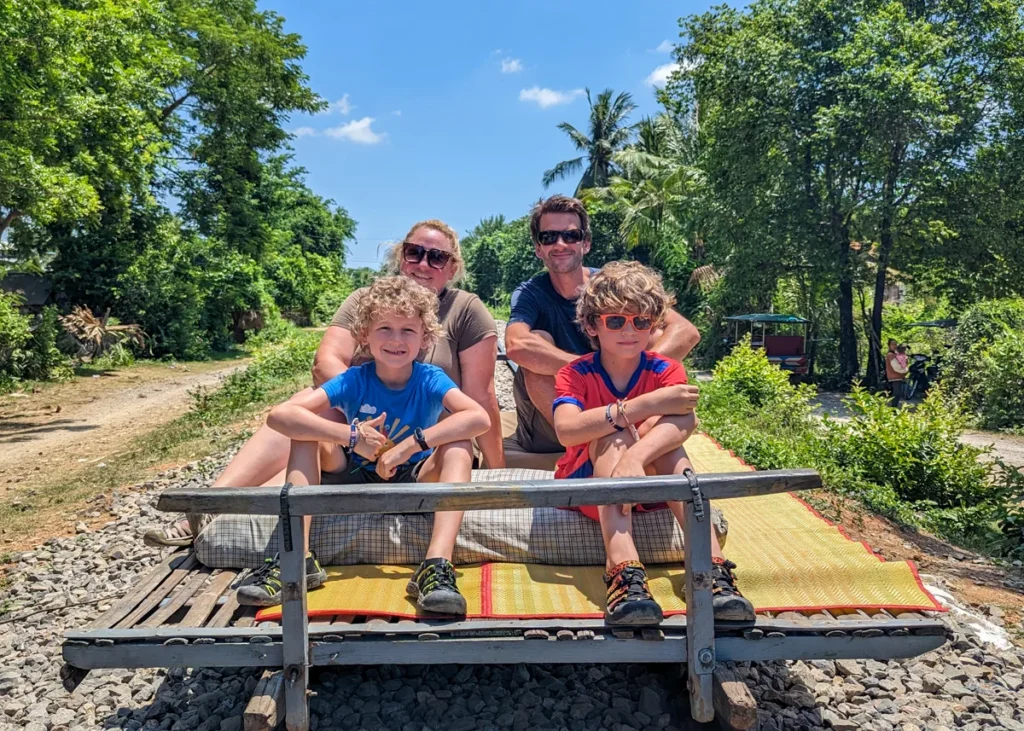Introduction
Let’s face it, international travel with kids can get expensive fast. Between flights, accommodations, meals, and activities, your dream vacation can start to feel more like a budget-busting nightmare. But what if we told you that you can explore the world with your family without emptying your savings account?
The key lies in smart planning, a bit of flexibility, and a few clever hacks that stretch every dollar. Budget travel doesn’t mean cutting out all the fun. It means spending wisely, prioritizing meaningful experiences, and finding value in the moments that matter most.
In this guide, we’re going to show you exactly how to plan an amazing international trip with your kids on a realistic budget. From cheap flights and free entertainment to budget-friendly meals and family discounts, every tip here is designed to help you save without sacrificing comfort or fun.
Planning Your Trip With a Family Budget in Mind
Choosing Budget-Friendly Destinations
Not all countries are created equal when it comes to cost. Choosing the right destination can instantly reduce your expenses without limiting your experience.
Look for countries where your home currency goes further. Destinations in Southeast Asia (like Thailand and Vietnam), parts of Central America (such as Costa Rica and Guatemala), and Eastern Europe (like Hungary and Bulgaria) offer incredible family adventures at a fraction of the price you’d pay in Western Europe or North America.
Research the following before deciding:
- Average cost of meals, accommodations, and transportation
- Family-friendliness (safety, healthcare, attractions for kids)
- Free public attractions or museums
Travel blogs, forums, and cost-of-living websites can help you estimate your daily spending. Sometimes the best family experiences come from countries you didn’t expect to be affordable.
When to Travel to Get the Best Prices
Timing is everything. Traveling during the high season,summer holidays, Christmas, or spring break,can skyrocket prices. If you want to save, travel in the shoulder seasons (spring and fall) or even the off-season.
Benefits of off-peak travel:
- Cheaper flights and hotels
- Fewer crowds at attractions
- More flexibility in bookings and cancellations
Be sure to check local school calendars too. While your kids may have time off, other countries may not, which can help you avoid peak periods.
Also, flying mid-week rather than on weekends can shave hundreds off airfare. Keep your schedule flexible and use tools like Google Flights, Skyscanner, or Hopper to track fare trends and price drops.
Setting a Realistic Travel Budget for Families
Budgeting doesn’t mean pinching pennies,it means knowing what you can comfortably spend and sticking to it. Start by breaking down your major expenses:
- Flights
- Accommodations
- Food and dining
- Transportation
- Activities and entertainment
- Travel insurance
- Miscellaneous/emergencies
Once you have a rough estimate, pad it by 10–15 percent for unexpected costs. Use spreadsheets or apps like Trail Wallet or Mint to track expenses and avoid going overboard.
Get your kids involved too. Show them how you’re planning and budgeting,it helps them understand the value of money and appreciate the experience more.
Finding Affordable Flights and Transportation
Tips for Scoring Cheap Family Flights
Flights are often the biggest single expense in an international trip. The good news? There are lots of ways to keep that number down.
Here’s how to fly smart:
- Book early, especially if traveling during school breaks
- Use fare comparison websites like Skyscanner or Kayak
- Set up fare alerts to track price drops
- Be flexible with departure dates and nearby airports
- Use incognito mode while searching to avoid price hikes
If you have points or miles, consider using them to offset ticket costs for one or more family members. Just make sure to account for any booking fees or blackout dates.
For families with infants, children under 2 often fly free (or at a reduced cost) on your lap. Still, bringing a car seat and booking a separate seat can be worth the added comfort.
Taking Advantage of Airline Perks for Kids
Some airlines offer free checked bags for kids, in-flight entertainment packages, early boarding for families, and kid meals,often without any extra cost. Check with your airline when booking to see what’s included.
Also, sign up for frequent flyer programs even for your kids. Over time, the points add up and can be redeemed for future flights or upgrades.
Ground Transportation: Public Transit vs. Rental Cars
Once you land, you’ll need to get around. Renting a car might sound convenient, but it can be pricey once you add in insurance, fuel, tolls, and parking fees.
Public transportation is almost always the cheaper,and often the better,option in big cities:
- Buy weekly or multi-day transport passes
- Use ride-share apps for short trips
- Walk whenever possible,it’s free and gives you a better sense of the city
In more rural destinations, a rental car might still be your best bet. Just compare prices ahead of time and look for discounts or free add-ons like child seats or GPS.
Budget-Friendly Accommodations for Families
Why Vacation Rentals Often Beat Hotels
When you’re traveling with kids, space and convenience are everything. That’s why vacation rentals through platforms like Airbnb or Vrbo are often better,and more affordable,than traditional hotels.
Here’s why rentals win:
- More space: Separate bedrooms mean better sleep for everyone.
- Kitchen access: Cook meals and save money on dining out.
- Laundry facilities: Pack lighter and avoid expensive hotel laundry services.
- Local feel: Staying in a neighborhood gives your family a taste of real local life.
Vacation rentals are often cheaper per night than hotel rooms, especially when traveling with more than one child. Plus, you can find child-friendly listings with cribs, high chairs, and toys already provided.
Just make sure to read reviews, check cancellation policies, and communicate with the host about any specific needs.
Hostels and Family Suites: Are They Worth It?
Hostels aren’t just for backpackers anymore. Many now offer private family rooms that include en-suite bathrooms, bunk beds, and even kitchenettes.
Benefits of staying in hostels with kids:
- Lower prices than hotels
- Often centrally located
- Great opportunities to meet other families
- Access to shared kitchens and lounges
Look for “family-friendly” or “family suites” when filtering listings. Sites like Hostelworld and Booking.com make it easy to compare options.
Some budget hotel chains, such as Premier Inn, Ibis, or B&B Hotels, offer clean, simple family rooms that include free breakfast and comfortable accommodations at great prices.
Saving Money on Lodging Without Sacrificing Comfort
Even if you’re set on hotels, there are still ways to save:
- Book early for better rates
- Use price comparison tools like Trivago or Google Hotels
- Check for discounts through AAA, AARP, or family travel clubs
- Stay just outside the city center where prices drop dramatically
- Use hotel points or loyalty programs for free stays or upgrades
Also, consider accommodations with free extras like breakfast, airport transfers, or evening snacks. These small perks can add up to big savings over the course of a family vacation.
Eating Well Without Breaking the Bank
How to Save on Meals While Traveling
Eating out three times a day with kids? That adds up fast. But you don’t have to sacrifice flavor or nutrition to stick to your budget.
Try these strategies:
- Book accommodations with breakfast included
- Eat your biggest meal at lunch when restaurants often have cheaper menus
- Limit restaurant meals to once per day and supplement with snacks or self-cooked food
- Share meals,portions are often large enough for two kids to split
Also, skip the tourist traps. Ask locals or check apps like Yelp or Google Reviews for small family-owned spots where you’ll get better prices and more authentic food.
Self-Catering and Grocery Shopping Abroad
One of the best ways to save money while traveling is to cook at least one meal a day. That’s why having access to a kitchen or kitchenette is so valuable.
Visit local grocery stores, supermarkets, or farmers’ markets for:
- Fresh produce and snacks
- Bread, cheese, and deli items for easy lunches
- Familiar brands that comfort picky eaters
Even simple meals like pasta, sandwiches, or omelets can save $30–$50 per day compared to dining out.
Also, let kids help pick out snacks,it’s fun for them and helps avoid waste. Look for local specialties to try at home for a budget-friendly cultural experience.
Kid-Friendly Snacks on a Budget
Snacks can make or break a day of sightseeing. Instead of constantly buying them on the go, stock up ahead of time.
Great travel snacks include:
- Granola bars
- Crackers or rice cakes
- Dried fruit and trail mix
- Refillable water bottles and juice boxes
- Hard-boiled eggs or string cheese if you have a cooler
Bring reusable containers to avoid waste and reduce impulse purchases at tourist sites where food prices are often inflated. Always carry a snack pack in your day bag,it can be a meltdown saver.
Free and Cheap Entertainment for Families
Exploring Free Attractions and Nature
One of the best parts of budget travel? Many of the world’s greatest experiences are completely free.
Take advantage of:
- Public parks and playgrounds
- Walking tours (many cities offer free options)
- Beaches and lakes
- Hiking trails and scenic overlooks
- Historic neighborhoods and local markets
Kids love running around and exploring, and these natural or public attractions often give you a more authentic feel of the destination than any paid ticket could.
Research free museum days, open-air performances, and walking routes before you go. Sites like Lonely Planet, Atlas Obscura, and local tourism boards are great resources.
Finding Local Events and Festivals
Check local calendars for seasonal festivals, fairs, and parades,many of which offer free entertainment, food tastings, games, and cultural exposure.
Search terms like “free events in [city] this weekend” or visit the destination’s official tourism site. Don’t be afraid to ask locals or your accommodation host,they often know about low-cost events that don’t show up online.
You’ll often discover family-oriented events like:
- Street food markets
- Music in the park
- Puppet shows
- Seasonal fairs
These experiences can be as memorable as expensive theme parks,and often more unique.
Budget-Friendly Museums and Family Discounts
Many museums around the world offer:
- Free admission days
- Reduced rates for children
- Family bundles or group tickets
Museums with hands-on or interactive exhibits are especially good for kids. Don’t skip the museum just because you think it’s pricey,check their website for specials or free kids’ programs first.
City tourism cards like the Paris Pass, London Explorer Pass, or Go City Cards can give you access to multiple museums and attractions at a discount, and often include public transport too.
Smart Packing to Avoid Extra Expenses
Packing Essentials to Avoid Unplanned Buys
One of the most overlooked ways to save money on international family travel is by packing wisely. Forgetting a few essentials might not seem like a big deal,until you have to buy overpriced sunscreen, a stroller, or kids’ medicine in a tourist hotspot.
Here’s what to always pack:
- Reusable water bottles
- Weather-appropriate clothing and layers
- Medications (prescription and over-the-counter)
- First aid kit
- Snacks and utensils
- Travel-size toiletries
- Child comfort items (blanket, stuffed animal)
- Portable charger and adapters
Packing familiar snacks and entertainment for kids can reduce costly impulse buys at airports or rest stops. Plus, having everything your family needs on hand helps avoid last-minute stress shopping.
Make a family checklist and cross-reference it a few days before you leave to avoid forgetting the basics.
Avoiding Baggage Fees and Packing Light
Checked bags are expensive,especially if you’re traveling with multiple family members. Save money by packing carry-on only, if possible, and sharing luggage space between children.
Here’s how to lighten the load:
- Roll clothes or use packing cubes to save space
- Choose versatile, mix-and-match outfits
- Limit shoes to one or two pairs per person
- Use travel-size toiletries
- Pack laundry detergent sheets and plan to wash mid-trip
Many family-friendly accommodations offer laundry machines or affordable services. Doing one or two loads can save you from packing a week’s worth of clothes.
Avoid overpacking bulky gear. Rent items like cribs, high chairs, or strollers at your destination through services like BabyQuip or local providers.
What to Buy vs. What to Bring
It’s tempting to bring everything “just in case,” but some things are cheaper or easier to buy when you arrive.
Bring:
- Prescription medications
- Specialty items (specific formula, allergy-safe snacks)
- Travel documents and electronics
Buy locally:
- Diapers and wipes
- Bulkier toiletries (shampoo, lotion)
- Beach toys or pool floaties
- Souvenirs
Also, if you’re traveling with another family, consider sharing gear like strollers or portable cribs to save both space and money.
Managing Money While Abroad
Choosing the Right Credit Cards and Currency Tips
Foreign transaction fees and bad exchange rates can add up fast. The right credit card can help you save with no fees and added travel rewards.
Look for a travel card that offers:
- No foreign transaction fees
- Cashback or travel points
- Purchase protection
- Emergency card replacement
Visa and Mastercard are widely accepted worldwide, but it’s always smart to carry a small amount of local currency for markets, transport, or places that don’t accept cards.
Exchange money at ATMs for the best rate,just make sure your bank card works abroad and avoid machines in tourist zones with poor exchange rates.
Avoiding Hidden Fees and Exchange Rate Pitfalls
When paying by card overseas, you may be asked whether to pay in your home currency or the local one. Always choose local currency,it avoids inflated conversion rates known as dynamic currency conversion.
Avoid airport currency exchange booths, as their rates are typically the worst. Use apps like XE or OANDA to check the real-time exchange rate before withdrawing or exchanging money.
Notify your bank about your travel dates so your card isn’t flagged for fraud while you’re abroad.
Budgeting Apps for Tracking Family Travel Expenses
Keeping an eye on your spending helps avoid that nasty surprise when you check your balance after the trip.
Top apps for tracking expenses:
- Trail Wallet – Designed for travelers, simple interface
- TravelSpend – Great for group or family trips
- Splitwise – Helpful if traveling with other families or friends
- Mint – Connects with your bank and tracks all spending
Set a daily spending limit and review each evening with your partner or kids. Staying informed helps you spot unnecessary expenses early and adjust your plans if needed.
Making the Most of Travel Rewards and Loyalty Programs

Using Points for Flights and Hotels
If you’re not using travel rewards, you’re leaving free money on the table. Credit card points, airline miles, and hotel loyalty programs can drastically reduce the cost of family trips.
Here’s how to start:
- Sign up for frequent flyer programs,even for your kids
- Use credit cards with generous sign-up bonuses and points for travel
- Book hotels through loyalty platforms like Marriott Bonvoy or Hilton Honors
Some families have flown internationally using only points for tickets,especially when booking far in advance or flying mid-week.
Be strategic: concentrate spending on one or two travel cards and redeem for the biggest expenses, like flights or hotel stays.
Airline and Hotel Family Perks
Many hotel chains offer perks like:
- Free breakfast
- Early check-in or late check-out
- Free stays for children under a certain age
- Room upgrades for loyalty members
Airlines may allow priority boarding, seat upgrades, or extra checked baggage based on status levels. Accumulate points consistently, and you’ll unlock benefits faster than you think.
Travel Rewards Cards That Benefit Families
Look for travel cards that earn:
- Points on groceries, gas, and travel (common family expenses)
- Bonus miles for dining out or transportation
- Sign-up offers worth at least one round-trip ticket
Top picks include:
- Chase Sapphire Preferred
- Capital One Venture
- American Express Gold Card
Always pay your balance in full to avoid interest. Used responsibly, these cards can supercharge your travel savings.
READ ALSO: 10 Destinations To Start Your Family Beach Trip In US 2025
Travel Insurance: Smart Protection or Extra Cost?
Finding Affordable Family Insurance Plans
You might think travel insurance is an extra cost you can skip,but for families, it can be a money-saver in disguise. From flight delays to sudden illnesses, one unexpected event could cost hundreds or even thousands without coverage.
Look for family plans that cover:
- Medical emergencies and evacuation
- Lost or delayed baggage
- Trip cancellations and delays
- COVID-19 coverage (if required)
Many providers offer group pricing for families with 2 or more children included for free.
Recommended companies:
- SafetyWing
- World Nomads
- Allianz Global Assistance
What to Look for in Budget Travel Insurance
Affordable doesn’t mean useless. A good policy should offer:
- At least $100,000 in emergency medical coverage
- 24/7 support hotlines
- Simple claims process
- Clear coverage for activities (e.g., swimming, hiking)
Avoid policies with high deductibles or tricky exclusions. Read reviews and ask questions if anything is unclear.
When It’s Worth Paying a Bit More for Coverage
If you’re going on a long trip, visiting a remote location, or traveling with a child with health needs, upgrading your policy is a smart move. It’s a small price to pay for peace of mind, especially when it comes to your children’s well-being.
Teaching Kids About Budget Travel
Making Kids Part of the Planning Process
Budget travel isn’t just for adults,it’s a great learning experience for kids, too. When children are involved in the planning, they feel empowered, excited, and more cooperative during the trip. It also introduces them to concepts like saving, spending wisely, and making smart choices.
Here’s how to include your kids in the travel planning:
- Let them help pick activities or places to visit within a set budget
- Give them a daily allowance for souvenirs or snacks
- Show them how flights or hotels are booked and why one is chosen over another
- Use visuals or charts to explain where the money goes
This hands-on approach helps them feel like valuable members of the travel team,not just tagalongs. Plus, it makes them more mindful of spending.
Fun Ways to Teach Budgeting and Saving on the Road
Make budgeting a game. Challenge your kids to:
- Find the best value souvenir under a certain price
- Help prepare simple meals and calculate the savings compared to dining out
- Track daily expenses in a travel journal
- Collect coins or small bills from each country to understand currency
Apps like iAllowance or even a simple notebook can make it fun and educational. Use “real world” situations,like comparing the price of ice cream at different spots,to develop their money sense.
You could also start a travel piggy bank before your trip, where kids contribute small amounts from allowance or chores to help fund an excursion. Watching their savings turn into a real adventure is incredibly rewarding.
Instilling a Love for Frugal, Meaningful Travel
The best memories rarely come from expensive tours or fancy restaurants. They come from moments like racing across a cobbled street to catch a bus, trying new foods at a market, or listening to music in a city square.
By traveling on a budget, you teach your children:
- Gratitude for simple joys
- Flexibility and problem-solving
- How to prioritize experiences over things
- Confidence in navigating the world
This mindset will benefit them for life, both on and off the road. As they grow, they’ll understand that traveling isn’t about luxury,it’s about curiosity, connection, and shared stories.
Conclusion
Traveling internationally with your kids doesn’t have to cost a fortune. With a thoughtful approach, smart budgeting, and a few savvy strategies, you can create unforgettable experiences for your family, without going into debt.
From scoring flight deals and choosing budget-friendly destinations to saving on meals and finding free fun, there are endless ways to cut costs while still traveling in comfort. It’s about being intentional with your money, knowing where to save, and recognizing when it’s worth spending a little more.
Budget travel with kids isn’t just possible,it can be magical. Because when you remove the stress of overspending, you open the door to what matters most: quality time, cultural discovery, laughter, and lifelong memories.
So start planning, pack light, and show your kids the world,one budget-friendly adventure at a time.
FAQs
What’s the cheapest way to fly internationally with kids?
Book flights early, use fare trackers, fly mid-week, and be flexible with travel dates. Children under two can often fly for free on your lap, though booking a seat can provide added comfort and safety.
Are budget airlines safe for family travel?
Yes, budget airlines are generally safe and regulated. However, be aware of limited amenities, stricter baggage rules, and extra fees for things like seat selection and carry-ons.
How can I keep food costs low while traveling abroad?
Cook your own meals, eat where locals eat, avoid tourist zones, and take advantage of hotel breakfasts and local grocery stores for snacks and drinks.
Is travel insurance really necessary for short family trips?
Yes. Even for short trips, travel insurance can cover medical emergencies, cancellations, lost baggage, and delays,especially important when traveling with kids.
What are the best destinations for budget-friendly family vacations?
Countries like Thailand, Portugal, Vietnam, Costa Rica, and Greece offer great value, family-friendly activities, and a low cost of living compared to many Western destinations.
In another related article, All-Inclusive Vacation Packages







